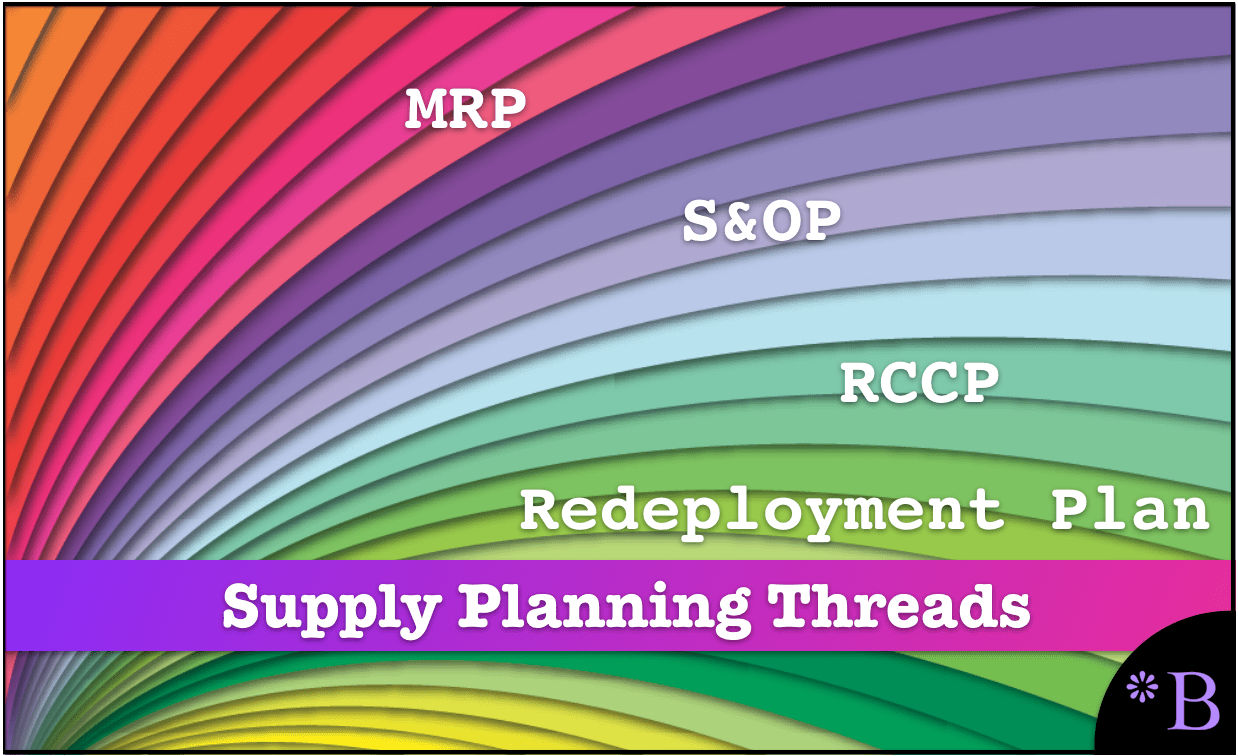How to Appreciate The Four Supply Planning Threads and Their Timing
Executive Summary
- There are four major supply planning threads which are distinct from planning runs.
- We also cover how a rough schedule or rough plan differs from a detailed schedule and S&OP, as well as the deployment plan, redeployment plan, and the timing of various supply planning threads as well as the differences between the threads.

Introduction
There is often a good deal of confusion as to what are the primary planning threads for supply planning. Therefore, I have spelled them out in this article.
Different threads make up the supply planning portion of the supply chain process. The supply chain process would include demand planning, supply planning, production planning, etc..
Planning Runs or Planning Threads?
These are often referred to as “planning runs.” However, this is a less accurate way of defining them.
This is because, in system terms, there are often multiple jobs or runs scheduled within each thread. For instance, one may schedule one grouping of product location combinations to be placed into one run, and then another group to be set in a second run and so on. For instance, one may hear someone say that after the “MRP run,” the results were XYZ.
However, the MRP run that is referred to may be comprised of one MRP run for a particular product group, another MRP run for another product group, and so on. But when the person is using the term MRP run, they are describing all of the MRP runs.
Therefore, I use the term threads instead of the more common “run” because there can be multiple planning runs within any one thread as part of that supply chain process.
Understanding the Threads of Supply Planning
These planning threads are most typically discussed independently from one another. However, they, have an everyday basis. They are the following:
- S&OP & Rough Cut Capacity Plan
- The Network/Initial Supply Plan (MRP)
- The Deployment Plan
- The Redeployment Plan
S&OP & Rough Cut Capacity Plan
These are used for long-range planning and, in most cases, are off-line analyses and are not part of the live environment. The term rough schedule or rough plan or rough capacity schedule is used to differentiate it from a detailed schedule. A rough plan is aggregated and will have only high-level resources information if it uses any resource information at all.
A rough plan, schedule, or capacity plan is intended to allow higher-ups to gain an overview. But the rough plan, schedule, or rough-cut capacity plan is only a high-level representation of what will occur and it is the starting point.
The Network/Initial Supply Plan: (performed by MRP in ERP systems)
Produces initial production and procurement plan. It is focused on bringing stock into the supply network, and in creating inventory with planned production orders. It can also be called the master production schedule (MPS) if the initial supply plan is run under specific criteria. This is covered in this article.
The Deployment Plan: (performed by DRP in ERP systems)
Focused on pushing stock from locations at the beginning of the supply network to the end of the supply network.
The Redeployment Plan: (performed by specialized applications with redeployment functionality or with a custom report)
Focused on repositioning stock, which is already in the supply network to locations where it has a higher probability of consumption. More on this in this article.
Timings of the Supply Chain Process Planning Threads
The following are the general frequency of the different supply planning processes.
- Rough Cut Capacity Plan / S&OP Run / MPS Run / Unconstrained Capacity Run: Weekly to Monthly
- Initial Supply Plan: Daily to Weekly
- Deployment Plan: Daily to Weekly
- Redeployment Plan: Weekly to Quarterly
Similarities Between the Supply Chain Process Planning Threads

The Differences Between the Supply Chain Planning Threads

More Details on the Supply Planning Threads
This article will be very different from what you may have read on this topic. This is because I see S&OP, MPS, and RCCP as all different cuts or derivations of the initial supply plan (all of which also contain the forecast and at least production, but in some cases supply planning constraints).
They are also defined by their level of granularity, whether they are a rough plan or a detailed plan.
- A series of supply planning methods and method modifiers were developed over time to create the initial supply plan.
- The MPS and RCCP are direct copies of the initial supply plan, with changes to their thread characteristics. For instance, a copy of the initial supply plan configuration may be put into a simulation version.
- The planning time the horizon may be lengthened, and its resources made unconstrained. (This will be demonstrated in just a few paragraphs.)
Conclusion
The S&OP thread is not a complete copy of the initial supply plan, as extra information is required, for instance, from finance. There are just a few adjustments and additions necessary to convert an initial supply plan into an S&OP plan and to fit within the supply chain process of planning.
The vast majority of supply planning applications are not designed to support S&OP within their applications natively. And the penetration of specialized S&OP applications is low. In most cases, supply planning applications support S&OP by providing extracts.
References
The various supply planning threads are covered in the following books.